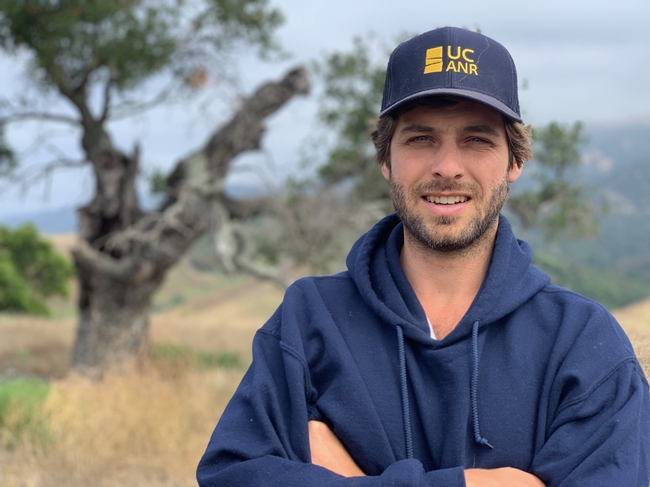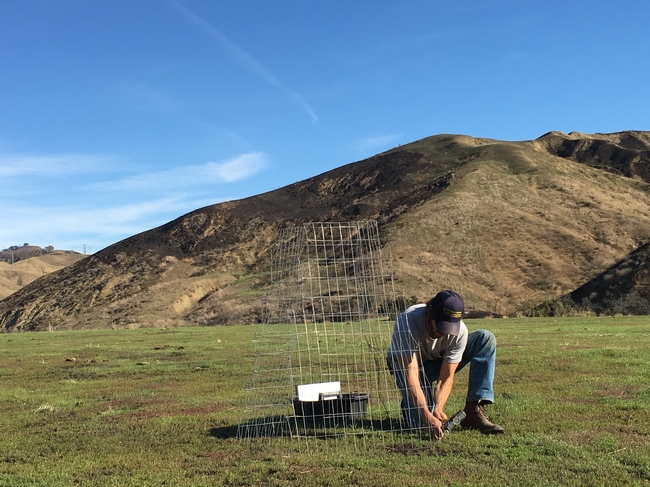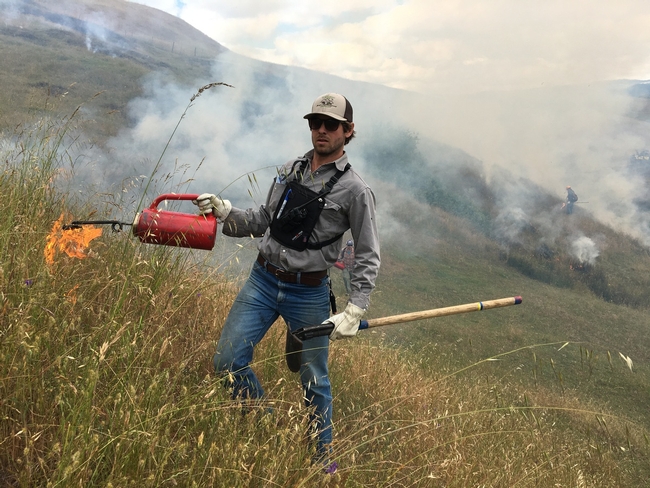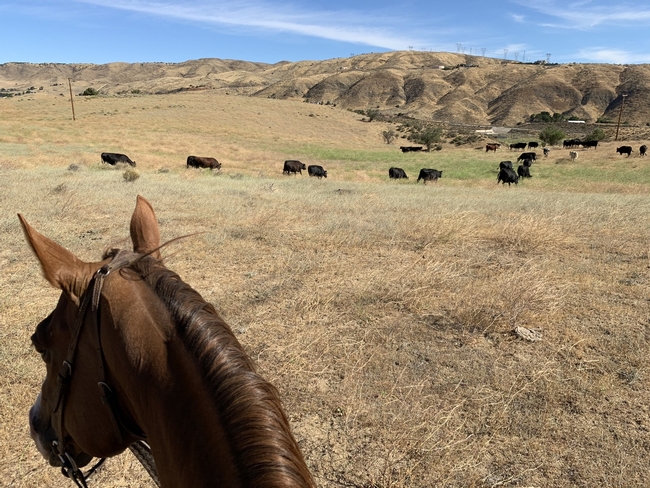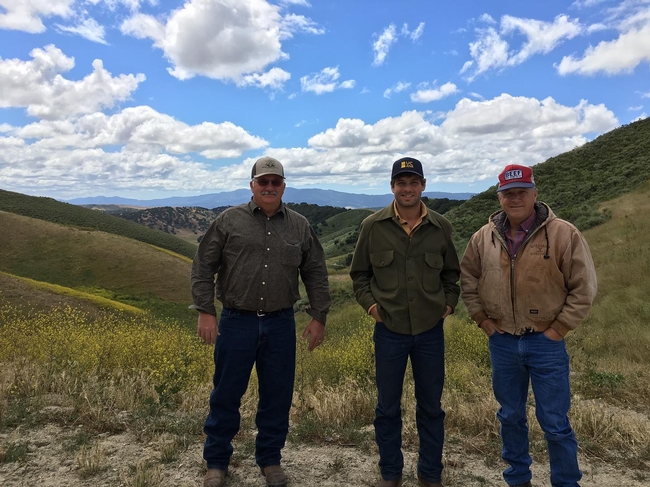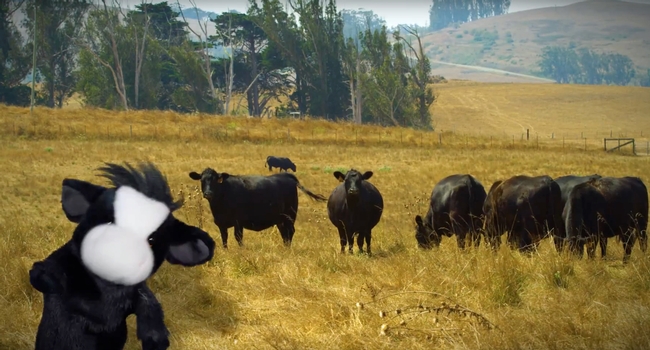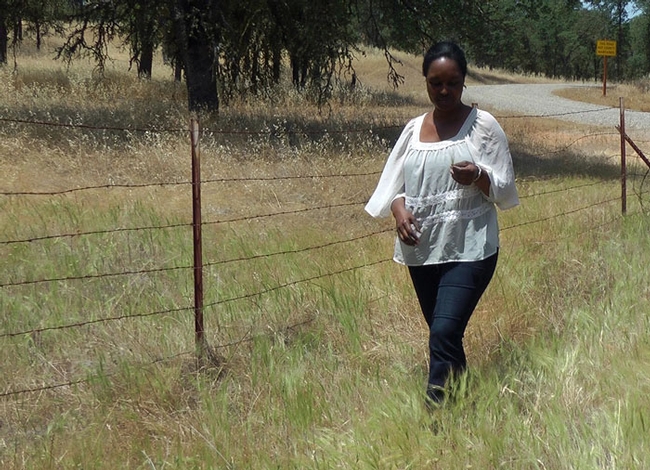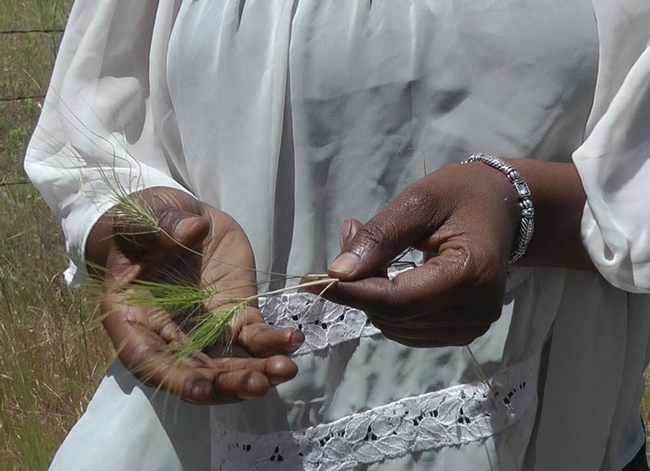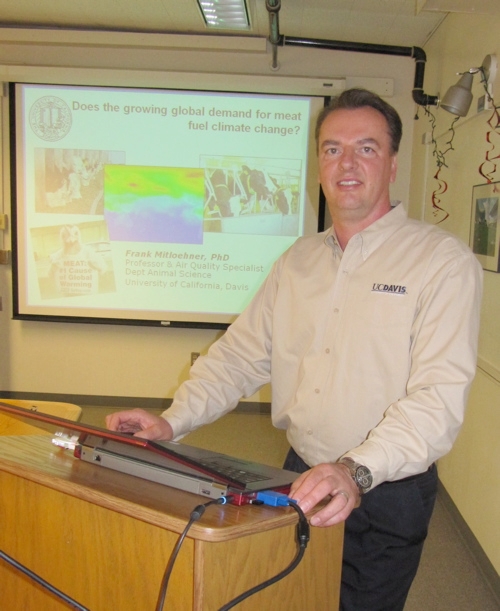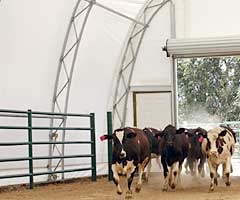Posts Tagged: livestock
Shapero protecting California’s natural resources
Rose Hayden-Smith, UC Cooperative Extension digital communications in food systems & extension educator, talked with Matthew Shapero about his work protecting California's natural resources. This is the second in a series featuring a few scientists whose work exemplifies UC ANR's public value for California.
Matthew Shapero is originally from California and has worked as an ANR Cooperative Extension livestock and range advisor since September 2017, based in Santa Barbara and Ventura counties. Matthew attended Columbia University and completed a Master of Science in range management from UC Berkeley. Prior to joining ANR, he farmed on the East Coast and in Nevada County, where he ran a ranch. His current research and Extension program focuses on several issues, including prescribed fire and how to prepare for and respond to wildfire. You can follow Matthew on Facebook and Instagram.
Tell us about your current research and Extension projects
I could certainly use the old ranching metaphor: “Way too many irons in the fire.” As a beginning advisor, one says “yes” to things that seem interesting and have promise, but projects develop in their own time. I'm currently working a great deal on wildfire issues, including prescribed fire and fire recovery. There's a need for long-term research to look at the effects of grazing as part of post-fire recovery. I am working with five ranches that experienced fire, and considering how land managers and agencies might be thinking about grazing and post wildfire recovery.
I'm also doing some research on soil seed bank, with a focus on how fire intensity impacts rangeland seed bank. [Editor's Note: “Soil seed bank” refers to the natural storage of seeds – often dormant – within the soil of ecosystems.]
Has thinking evolved on prescribed fire?
It has. I received an M.S. degree in range management from UC Berkeley. The program didn't cover much of the research and practices around prescribed fire, because it seemed to be an unrealistic land management tool in today's day and age. The Thomas fire occurred in December 2017, just three months after I started my work as a Cooperative Extension advisor. I've seen the political winds shift since then; prescribed fire has become much more palatable in this area since Thomas, as a technique to proactively deal with the threat of catastrophic wildfire.
There's a relatively short window (a couple of months annually) where the conditions and circumstances are aligned for prescribed burning. In Fall 2018, I was involved in a prescribed burn of 380 acres using a type of private burn permitting that hadn't been used in a long time. As a Cooperative Extension advisor, I played a relatively important role in connecting the dots and helping that burn get up and off the ground. Part of my work is nudging people, following up, connecting people. I think my work is a good example of how a Cooperative Extension advisor inserts himself/herself into the process. With ranchers, private landowners, county fire agencies and others involved, there is a need for good communication.
In the aftermath of that burn, I organized an event for elected officials, agency heads, and other decision makers to visit the prescribed burn site. It was helpful for them.
My program covers Ventura and Santa Barbara counties, which have different histories with prescribed fire. Santa Barbara County has had a strong range improvement association from the 1950s through the present, which conducted prescribed burns at a significant rate up through the 1990s. For example, between 1955 and 1964, this association burned over 100,000 acres in private land, with little assistance from the county fire department.
This is in contrast to Ventura County, which has less of a surviving rancher-led burn culture. While producers burned within the county, there is no formal existing organization that plans and executes burns. I've been helping to revive burn culture in Santa Barbara County, but there's been less to draw on in Ventura County. Both have county fire agencies instead of CalFIRE. They are supportive of private-led burning, but to actually implement prescribed burns is easier in Santa Barbara County than in Ventura County. Ranchers and private landowners in Santa Barbara are more comfortable with fire, and many have some of the resources required (water tending trucks, drip torches, flamethrowers, etc.). We're building momentum, though, and the conversation has shifted since the Thomas Fire.
Did the Thomas Fire change perceptions about the value of ranchland in Southern California?
The Thomas Fire demonstrated that even if you live in a city or suburb, the way natural resources are managed impacts you. Livestock production is not an agricultural sector that generates a lot of gross revenue (it barely registers in the list of top 10 crops by revenue in each county), but it has great spatial impact. How it is managed impacts water quality, wildlife habitat, and the view those living on the peri-urban interface enjoy. There is important public and economic value in the way rangelands are managed.
What are the challenges facing the ranching industry in Southern California?
The challenges the ranching industry faces in Southern California aren't necessarily new. I recently came across an Extension research bulletin published in 1972 that explained how Santa Barbara County was trialing new nitrogen fertilizer on rangeland. My predecessors identified “rising taxes and land scarcity” as challenges facing ranchers, and these things would still hold true.
These challenges are not unique in California, but the impact may feel different here. The Southern California counties in particular have a long and deep ranching history that was defined in many ways by Spanish ranchos.
The industry is potentially at a critical breaking point, though. It's not just land, but the lack of supporting infrastructure. For example, it's much more difficult to get cattle trucks down here; the nearest approved USDA slaughter house is hours away, and the nearest sale yard is in Kern or Monterey County. In Santa Barbara County, there is increasing pressure for land conversion and land use change. Many individuals are interested in creating vineyards and estates, which is breaking up and making into smaller parcels larger ranches, so that they can no longer be run profitably as livestock operations.
In an optimistic sense, there has been a shift in public opinion over the last 20 years about ranching. At one time, ranching was vilified as being harmful to land, especially public lands. The Bay Area has had more sophisticated conversations about how ranching and environmentalism can co-exist, and what the co-benefits are.
There is every reason to think that the conversation around ranching will mature and become more nuanced in Southern California as well. Topics such as water quality and endangered species - which seemed like flashpoints and a source of friction – have given way to discussions that identify areas of co-benefit. Ranchers do so much for wildlife in keeping rangelands open and undeveloped. But they are often targeted with what they regard as unfair legislation around fencing and vegetation removal. Urban public opinion should recognize the value of keeping ranchers on the land.
Why are you working for Cooperative Extension?
I'm interested in the public value aspects of the work. Traditionally, Cooperative Extension measured the impact of our work by the increase of forage grown per acre, or the number of pounds of beef extracted from a ranch. While those things are important, I see our role expanding. In addition to increasing agricultural production, my work is also about the potential to engage on policy and on a cultural level.
Livestock advisors throughout the state are an important point of nexus in terms of communicating the value of ecosystems management. We are often the connection between the broader general public and an agricultural constituency. I spend a lot of my time translating how and why ranching benefits the general public, why cattle might be good for the planet (not bad), and why cattle have ecosystem benefits for rangelands. I find as much as my work is increasing and improving herd health, it is also lubricating public policy discussions, and providing analysis that has benefits for ranchers and the general public.
Extension grounds positions in science and through neutrality. There is an important role for Extension in facilitating the conversations that identify mutual benefits.
Videos show hikers how to avoid Black Friday stampedes on park trails
While Americans traditionally beat a path to the malls the day after Thanksgiving, many opt out of shopping on Black Friday to enjoy the outdoors. In regional parks and other open spaces, hikers may encounter crowds of a different sort – cattle grazing with their calves. A 1,200-pound cow blocking the path can be daunting.
With a little patience and understanding, people who hike, bike and horseback ride can coexist peacefully with the cattle, according to Sheila Barry, UC Cooperative Extension livestock and natural resources advisor in Santa Clara County.
For happier trails, UC Agriculture and Natural Resources has produced a series of videos that show hikers how they can amicably share open space with their beefy neighbors. In a two-minute video, a black cow puppet with a furry white face describes how to politely coax cows to moo-ove aside without spurring a Black Friday stampede.
“We wanted to produce videos that are entertaining as well as informative,” Barry said.
The cow pun-filled video also describes the ecosystem services cattle provide by consuming nearly their body weight in plants. By grazing, cows manage the vegetation, reducing wildfire fuel, increasing water capture and promoting the diversity of native grasses and wildflowers.
In “Sharing open spaces with livestock,” the UC Agriculture and Natural Resources livestock experts give four simple tips for safely sharing open space with cows on the trail:
- Keep moo-ving and speak in a normal tone. Sudden movements and loud noises may surprise cows.
- Approach cows from the side or front. They find it udderly unnerving to have someone sneak up from behind, the bovine blind spot.
- Steer clear of getting between a protective mother and her calf.
- If you need to move a cow, step slowly into its flight zone. Invading the animal's “personal space” will motivate it to mosey aside.
A second video, “Sharing open spaces with livestock when you have a dog,” gives advice for dog owners to keep their best friends safe around cows.
In a third video, “A year in the life of a cow,” the UC Cooperative Extension spokespuppet describes a typical year for a beef cow.
“The videos are a fun way to educate the public about grazing on rangelands,” said Stephanie Larson, UC Cooperative Extension livestock and rangeland advisor in Sonoma County.
The videos are based on the UC ANR publication “Understanding Working Rangelands,” authored by Barry and Larson, at http://ucanr.edu/shareopenspace.
Watch all three videos on UC ANR's YouTube channel:
Sharing open spaces with livestock https://youtu.be/Qd8LEGLDhaM
Sharing open spaces with livestock when you have a dog https://youtu.be/zzdGnfFwmcA
A year in the life of a cow https://youtu.be/znJbWknVXVg
Watch out for fiddleneck and groundsel in livestock feed - Toxic Weeds in Alfalfa
Fiddleneck is everywhere this year, and common groundsel is common too! As winter annuals, these weeds are early-season plants. They tend...
Ranchers concerned about invasion of medusahead weed on foothill rangeland
One of the worst rangeland weeds in the West is aptly named after a monster in Greek mythology that has writhing snakes instead of hair.
Medusahead, an unwelcome transplant from Europe, is anathema to the cattle living off rangeland grass. The weed's three-inch-long bristles poke and sometimes injure the animals' mouths and eyes. The weed is also low-quality forage for livestock. When medusahead takes over rangeland, it reduces the forage value by 80 percent.
When Fadzayi Mashiri, UC Cooperative Extension advisor in Mariposa, Merced and Madera counties, was appointed in 2013, she became the first natural resources and rangeland expert to hold the position since the retirement of Wain Johnson more than a decade before. She polled local ranchers to determine their most pressing problems. They said weed management, and in particular, medusahead.
Medusahead is relatively easy to identify on the range. It has distinctive stiff awns and a seed head that does not break apart as seeds mature. Patches of medusahead are obvious when spring turns into summer.
“Medusahead stays green after most of the annual grasses have dried off,” Mashiri said.
Medusahead has high silica content, making it unpalatable to cattle. The silica also protects the plant from decomposition, so a thick thatch builds up on the rangeland, suppressing more desirable species, but not the germination of the next year's medusahead seedlings.
Over the years, UC scientists have discovered a number of medusahead control strategies:
- Corral cows on medusahead before the plant heads out or employ sheep to graze medusahead patches. It's not sheep's favorite forage either, but they will eat if left with no other option.
- Prescribed burning in late spring or early summer. However, this strategy poses air quality and liability issues.
- Apply nitrogen fertilizer to medusahead to improve palatability before it flowers, which is showing promise for controlling the weed and boosting the value of infested rangeland.
- Chemical control.
In spring 2014, Mashiri conducted a demonstration field trial in Mariposa County of medusahead control with the herbicide Milestone, which was developed by Dow AgroSciences mainly to control broadleaf weeds like yellow starthistle. The trial followed rangeland weed control research done by scientists including Joe DiTomaso, UC Cooperative Extension specialist in the Department of Plant Sciences at UC Davis. DiTamaso found that the density of medusahead in treated areas declined and concluded that Milestone prevents medusahead seedlings from thriving.
Unfortunately, Milestone treatment of large rangeland areas is expensive.
“But if the value of forage declines, the productivity of livestock is compromised,” Mashiri said. “When you look at it that way, the chemical treatment might be useful.”
Is livestock’s contribution to climate change still being overestimated?
In a 1,000 year old village in Germany (Juehnde), methane is not a dirty word. The recovered methane from a manure-fueled bioreactor feeds the burners that heat water for every household in the village. The same hot water provides heating. These households benefit from living adjacent to a livestock economy whose manure was once just a smelly nuisance. The manure is transported by truck to an enclosed bioreactor, thereby reducing odor and feeding a system that powers an entire community. Frank Mitloehner once called this village home. Now a professor and air quality UC Cooperative Extension specialist in the Department of Animal Science at UC Davis, Mitloehner thinks that if this village can do it, so can California.
It is easy to see how Mitloehner was inspired to study ways that California can take advantage of its plentiful supplies of animal methane. In eight bovine bio-bubbles that function as airtight barns, he captures and measures every emission from his resident livestock in order to understand how methane emissions vary with feed and herd management.
At Davis, a commercialized version of a similar methane bio-reactor has been patented and licensed by Ruihong Zhang, professor in the Department of Biological and Agricultural Engineering at UC Davis. It has been constructed at the local landfill and will be used to demonstrate a sustainable village on the UC Davis campus.
Mitloehner recently hosted a seminar for the Western Center for Agricultural Health and Safety at Davis. Since the Food and Agriculture Organization of the United Nations (FAO) committee released their 2006 report entitled, “Livestock’s Long Shadow,” he has challenged two key misleading sentences in their report. The phrase compared the contribution of livestock emissions to that of transportation. By saying the contributions to climate change were similar, the report led many environmental advocates to the conclusion that eating less meat was the equivalent of taking cars off the road, setting up a meat vs. miles tradeoff that exaggerated the methane contributions of livestock everywhere.
Mitloehner’s response was the publication Clearing the Air, Livestock’s Contribution to Climate Change. After his paper was released, BBC, CNN and other media published his science-based estimate that the livestock contribution in the U.S. is 3.4 percent of U.S. emissions. Globally, 18 percent of warming was estimated to be livestock related. This estimate included livestock in the broadest sense - changes in land use, deforestation and desertification in developing countries.
In spite of Mitloehner’s paper, the meat vs. miles perception has persisted among advocates, while press about transportation GHG has dwindled. Toyota took advantage in their advertising by showing how Prius emissions were more favorable than those of a sheep.
Nonetheless, Mitloehner showed that U.S. methane emissions remain flat, while developing countries are increasing animal production to meet the demand for eggs, meat and dairy, especially Asia. But why is the U.S. so low?
Mitloehner shared a few facts that help explain the phenomena:
- The U.S. has fewer dairy cows. Today’s 9 million dairy cows supply 60 percent more milk than the 16 million cows in production in 1950. That means there is increased efficiency per cow for the same methane produced.
- Thirty percent of the methane in dairy production is from manure in ponds. There is the potential for recovery on the approximately 1,500 California farms, where the average herd size is 1,100 head.
- Methane has 20 times the warming potential of carbon dioxide, but when burned to heat water or to generate power, its warming potential is reduced by a factor of 20.
- The more fiber in the feed, the more methane is released by the rumen of the animal. One dairy cow in the U.S. produces an average of 20,000 lbs of milk per cow annually, the same amount of milk as five cows in Mexico, or up to 100 cows in India for the same, or less methane per cow. Reasons: low fiber diet, less parasites and less disease result in large differences in production per cow.
Mitloehner occupies that middle space between the economically driven farmers who survived years of falling milk prices and the sustainable advocates that want dairy to either disappear entirely or retreat into historical practices. When he is not serving on the President’s Council of Advisors on Science and Technology (PCAST) or the National Academies Institute of Medicine, he keeps company with local farmers and students and answers to science.
Dairy addicts like myself, whose ancestors have evolved on milk for over 10,000 years, are likely to continue to frequent the organic dairy cases, hopeful that there are mutual benefits to paying higher prices for local labels in returnable glass bottles as a way to sustain the farms.
In reality, California has been exporting surplus dairy products to growing populations since the 1890s and that won’t change soon. Those markets do more to keep dairies profitable than my weekly milk and yogurt purchase. Lactose for pharmaceuticals and whey proteins for infant formulas are shipped internationally from several of California’s mammoth cheese factories, sometimes worth more the cheese itself.
Mitloehner believes that “sustainable intensification” is the solution to keeping local dairies viable. He believes that science will provide the path to better regulation. The dairy nations that seem determined to get at the truth - New Zealand, France, Ireland and the Netherlands - have formed an international partnership at FAO entitled LEAP to address the issues. Mitloehner's leadership a chair of the partnership will keep methane bioreactors on the agenda.
More information:
Mitloehner tells the story of how he neutralized errors in the FAO report “Livestock’s Long Shadow” (YOUtube).
LEAP site at the FAO. NGOs include World Wildlife Federation and Greenpeace. Mitloehner said that Greenpeace is also a partner although not listed on the site. Workshop materials available for download.
July 2012 opinion post by Robert Goodland at New York Times food blog. This is an example of criticism of Mitloehner’s role as head of the FAO partnership LEAP (Livestock Environmental Assessment and Performance).


